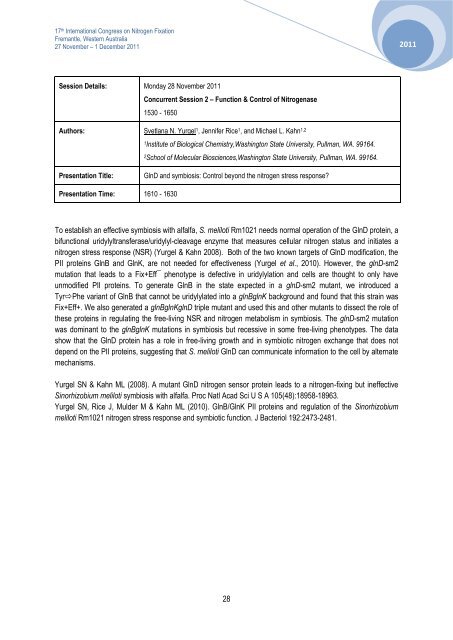IN INOCULANTS Nodulaid - 17th International Nitrogen Fixation ...
IN INOCULANTS Nodulaid - 17th International Nitrogen Fixation ...
IN INOCULANTS Nodulaid - 17th International Nitrogen Fixation ...
You also want an ePaper? Increase the reach of your titles
YUMPU automatically turns print PDFs into web optimized ePapers that Google loves.
17 th <strong>International</strong> Congress on <strong>Nitrogen</strong> <strong>Fixation</strong><br />
Fremantle, Western Australia<br />
27 November – 1 December 2011<br />
Session Details: Monday 28 November 2011<br />
Concurrent Session 2 – Function & Control of <strong>Nitrogen</strong>ase<br />
1530 - 1650<br />
Authors: Svetlana N. Yurgel 1 , Jennifer Rice 1 , and Michael L. Kahn 1,2<br />
1 Institute of Biological Chemistry,Washington State University, Pullman, WA. 99164.<br />
2 School of Molecular Biosciences,Washington State University, Pullman, WA. 99164.<br />
Presentation Title: GlnD and symbiosis: Control beyond the nitrogen stress response?<br />
Presentation Time: 1610 - 1630<br />
To establish an effective symbiosis with alfalfa, S. meliloti Rm1021 needs normal operation of the GlnD protein, a<br />
bifunctional uridylyltransferase/uridylyl-cleavage enzyme that measures cellular nitrogen status and initiates a<br />
nitrogen stress response (NSR) (Yurgel & Kahn 2008). Both of the two known targets of GlnD modification, the<br />
PII proteins GlnB and GlnK, are not needed for effectiveness (Yurgel et al., 2010). However, the glnD-sm2<br />
mutation that leads to a Fix+Eff¯ phenotype is defective in uridylylation and cells are thought to only have<br />
unmodified PII proteins. To generate GlnB in the state expected in a glnD-sm2 mutant, we introduced a<br />
Tyr�Phe variant of GlnB that cannot be uridylylated into a glnBglnK background and found that this strain was<br />
Fix+Eff+. We also generated a glnBglnKglnD triple mutant and used this and other mutants to dissect the role of<br />
these proteins in regulating the free-living NSR and nitrogen metabolism in symbiosis. The glnD-sm2 mutation<br />
was dominant to the glnBglnK mutations in symbiosis but recessive in some free-living phenotypes. The data<br />
show that the GlnD protein has a role in free-living growth and in symbiotic nitrogen exchange that does not<br />
depend on the PII proteins, suggesting that S. meliloti GlnD can communicate information to the cell by alternate<br />
mechanisms.<br />
Yurgel SN & Kahn ML (2008). A mutant GlnD nitrogen sensor protein leads to a nitrogen-fixing but ineffective<br />
Sinorhizobium meliloti symbiosis with alfalfa. Proc Natl Acad Sci U S A 105(48):18958-18963.<br />
Yurgel SN, Rice J, Mulder M & Kahn ML (2010). GlnB/GlnK PII proteins and regulation of the Sinorhizobium<br />
meliloti Rm1021 nitrogen stress response and symbiotic function. J Bacteriol 192:2473-2481.<br />
28<br />
2011


